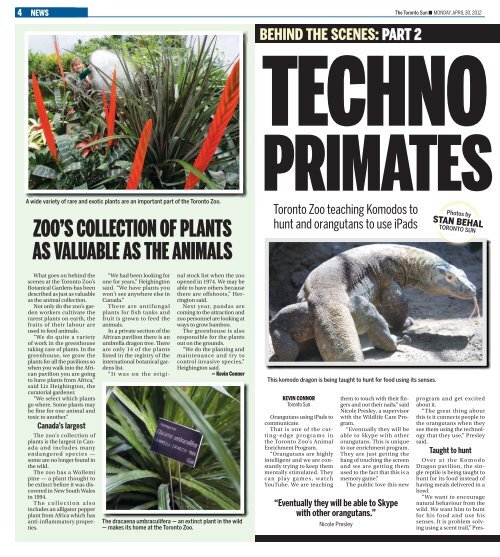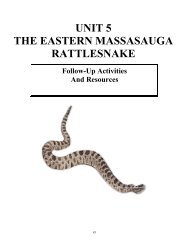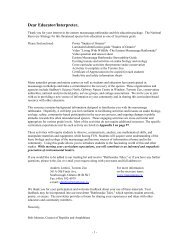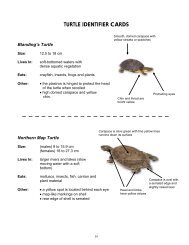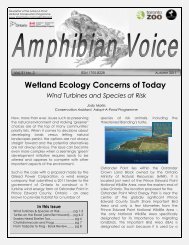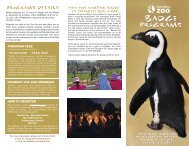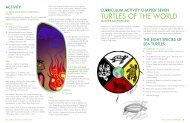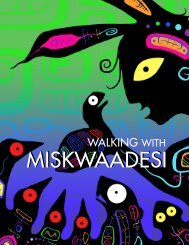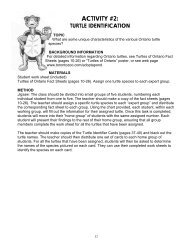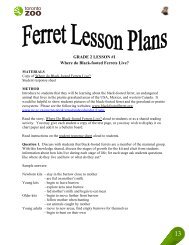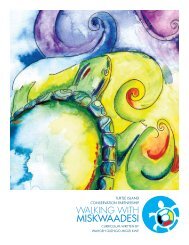Toronto Sun Behind the scenes: Part 2 - Toronto Zoo
Toronto Sun Behind the scenes: Part 2 - Toronto Zoo
Toronto Sun Behind the scenes: Part 2 - Toronto Zoo
Create successful ePaper yourself
Turn your PDF publications into a flip-book with our unique Google optimized e-Paper software.
4 NEWS<br />
BEhiNd thE ScENES: <strong>Part</strong> 2<br />
The <strong>Toronto</strong> <strong>Sun</strong> n Monday, april 30, 2012<br />
Techno<br />
PrimaTeS<br />
A wide variety of rare and exotic plants are an important part of <strong>the</strong> <strong>Toronto</strong> <strong>Zoo</strong>.<br />
<strong>Zoo</strong>’S collecTion of PlanTS<br />
aS valuable aS The animalS<br />
<strong>Toronto</strong> <strong>Zoo</strong> teaching Komodos to<br />
hunt and orangutans to use iPads<br />
Photos by<br />
STAN BEHAL<br />
TORONTO SUN<br />
What goes on behind <strong>the</strong><br />
<strong>scenes</strong> at <strong>the</strong> <strong>Toronto</strong> <strong>Zoo</strong>’s<br />
Botanical Gardens has been<br />
described as just as valuable<br />
as <strong>the</strong> animal collection.<br />
Not only do <strong>the</strong> zoo’s garden<br />
workers cultivate <strong>the</strong><br />
rarest plants on earth, <strong>the</strong><br />
fruits of <strong>the</strong>ir labour are<br />
used to feed animals.<br />
“We do quite a variety<br />
of work in <strong>the</strong> greenhouse<br />
taking care of plants. In <strong>the</strong><br />
greenhouse, we grow <strong>the</strong><br />
plants for all <strong>the</strong> pavilions so<br />
when you walk into <strong>the</strong> African<br />
pavilion you are going<br />
to have plants from Africa,”<br />
said Liz Heighington, <strong>the</strong><br />
curatorial gardener.<br />
“We select which plants<br />
go where. Some plants may<br />
be fine for one animal and<br />
toxic to ano<strong>the</strong>r.”<br />
Canada’s largest<br />
The zoo’s collection of<br />
plants is <strong>the</strong> largest in Canada<br />
and includes many<br />
endangered species —<br />
some are no longer found in<br />
<strong>the</strong> wild.<br />
The zoo has a Wollemi<br />
pine — a plant thought to<br />
be extinct before it was discovered<br />
in New South Wales<br />
in 1994.<br />
The collection also<br />
includes an alligator pepper<br />
plant from Africa which has<br />
anti-inflammatory properties.<br />
“We had been looking for<br />
one for years,” Heighington<br />
said. “We have plants you<br />
won’t see anywhere else in<br />
Canada.”<br />
There are antifungal<br />
plants for fish tanks and<br />
fruit is grown to feed <strong>the</strong><br />
animals.<br />
In a private section of <strong>the</strong><br />
African pavilion <strong>the</strong>re is an<br />
umbrella dragon tree. There<br />
are only 14 of <strong>the</strong> plants<br />
listed in <strong>the</strong> registry of <strong>the</strong><br />
international botanical gardens<br />
list.<br />
“It was on <strong>the</strong> original<br />
stock list when <strong>the</strong> zoo<br />
opened in 1974. We may be<br />
able to have o<strong>the</strong>rs because<br />
<strong>the</strong>re are offshoots,” Herrington<br />
said.<br />
Next year, pandas are<br />
coming to <strong>the</strong> attraction and<br />
zoo personnel are looking at<br />
ways to grow bamboo.<br />
The greenhouse is also<br />
responsible for <strong>the</strong> plants<br />
out on <strong>the</strong> grounds.<br />
“We do <strong>the</strong> planting and<br />
maintenance and try to<br />
control invasive species,”<br />
Heighington said.<br />
— Kevin connor<br />
The dracaena umbraculifera — an extinct plant in <strong>the</strong> wild<br />
— makes its home at <strong>the</strong> <strong>Toronto</strong> <strong>Zoo</strong>.<br />
This komodo dragon is being taught to hunt for food using its senses.<br />
KEViN cONNOr<br />
<strong>Toronto</strong> <strong>Sun</strong><br />
Orangutans using iPads to<br />
communicate.<br />
That is one of <strong>the</strong> cutting-edge<br />
programs in<br />
<strong>the</strong> <strong>Toronto</strong> <strong>Zoo</strong>’s Animal<br />
Enrichment Program.<br />
“Orangutans are highly<br />
intelligent and we are constantly<br />
trying to keep <strong>the</strong>m<br />
mentally stimulated. They<br />
can play games, watch<br />
YouTube. We are teaching<br />
<strong>the</strong>m to touch with <strong>the</strong>ir fingers<br />
and not <strong>the</strong>ir nails,” said<br />
Nicole Presley, a supervisor<br />
with <strong>the</strong> Wildlife Care Program.<br />
“Eventually <strong>the</strong>y will be<br />
able to Skype with o<strong>the</strong>r<br />
orangutans. This is unique<br />
to our enrichment program.<br />
They are just getting <strong>the</strong><br />
hang of touching <strong>the</strong> screen<br />
and we are getting <strong>the</strong>m<br />
used to <strong>the</strong> fact that this is a<br />
memory game.”<br />
The public love this new<br />
“Eventually <strong>the</strong>y will be able to Skype<br />
with o<strong>the</strong>r orangutans.”<br />
nicole presley<br />
program and get excited<br />
about it.<br />
“The great thing about<br />
this is it connects people to<br />
<strong>the</strong> orangutans when <strong>the</strong>y<br />
see <strong>the</strong>m using <strong>the</strong> technology<br />
that <strong>the</strong>y use,” Presley<br />
said.<br />
Taught to hunt<br />
Over at <strong>the</strong> Komodo<br />
Dragon pavilion, <strong>the</strong> single<br />
reptile is being taught to<br />
hunt for its food instead of<br />
having meals delivered in a<br />
bowl.<br />
“We want to encourage<br />
natural behaviour from <strong>the</strong><br />
wild. We want him to hunt<br />
for his food and use his<br />
senses. It is problem solving<br />
using a scent trail,” Pres-
The <strong>Toronto</strong> <strong>Sun</strong> n Monday, april 30, 2012 NEWS 5<br />
Jealous of <strong>the</strong><br />
orangutan, a<br />
white-handed<br />
gibbon waits to<br />
get his own iPad.<br />
Wildlife nutritionist Karen Alexander, assistant Lisa Leneevin, and nutritionist Jaap Wensvoort exhibit one day of food<br />
for Samson, <strong>the</strong> grizzly bear who calls <strong>the</strong> <strong>Toronto</strong> <strong>Zoo</strong> home.<br />
Frozen Mice, rats, rabbits, Monkey<br />
chow, and 60,000 crickets a week<br />
Sumatran orangutan Ramai and daughter Jingga watch<br />
<strong>Toronto</strong> <strong>Zoo</strong> visitors watching <strong>the</strong>m.<br />
ley said.<br />
The zoo’s komodo has had<br />
problems with arthritis and<br />
<strong>the</strong> program is meant to keep<br />
him active.<br />
Sumatran tigers are good<br />
tree climbers and <strong>the</strong> zoo<br />
wants <strong>the</strong> public to know that.<br />
“We want him hunting for<br />
food so we put horse meat up<br />
in <strong>the</strong> trees so he will climb.<br />
When he is climbing he is<br />
using different muscles than<br />
when he is walking,” Presley<br />
said.<br />
“It is great entertainment<br />
for people and hopefully<br />
it will encourage <strong>the</strong>m<br />
to do research and learn how<br />
endangered <strong>the</strong>y are.”<br />
kevin.connor@sunmedia.ca<br />
The <strong>Toronto</strong> <strong>Zoo</strong> has <strong>the</strong><br />
biggest restaurant in <strong>the</strong><br />
world.<br />
<strong>Zoo</strong> workers serve up<br />
more than 500 different<br />
dishes each day to meet <strong>the</strong><br />
nutritional needs of 6,000<br />
animals.<br />
The meals include frozen<br />
rodents — mice, rats, and<br />
rabbits — monkey chow,<br />
canned goods and produce<br />
that can be bought in a grocery<br />
store. The zoo’s grocery<br />
bill is about $1 million<br />
a year.<br />
“Some of our fruits and<br />
vegetables don’t have <strong>the</strong><br />
same nutrients as <strong>the</strong> animals<br />
would get in <strong>the</strong> wild<br />
so we have to boost that. We<br />
need to put supplements<br />
into some things and things<br />
have to be removed from<br />
o<strong>the</strong>rs. This isn’t like my personal<br />
shopping list but everything<br />
here is fit for human<br />
consumption,” said nutritionist<br />
Karen Alexander.<br />
“We do a lot of quality<br />
control and things are prepared<br />
to our specifications.<br />
The animals get different<br />
food every day. Nuts, seeds,<br />
grains, fruits and vegetables.<br />
We use colourful<br />
things so <strong>the</strong> animals don’t<br />
get bored. A lot of animals<br />
are visual eaters.”<br />
Often, <strong>the</strong> meals are hidden<br />
in <strong>the</strong> animals’ pens<br />
so <strong>the</strong>y have to forage for it<br />
like <strong>the</strong>ir wild cousins.<br />
“They need to have<br />
something to do. A gorilla<br />
walking through <strong>the</strong> forest<br />
would pick things up looking<br />
for food,” Alexander<br />
said.<br />
Some animals need to<br />
have live food like crickets.<br />
In fact, <strong>the</strong> zoo goes<br />
through 60,000 crickets in<br />
a week.<br />
One of <strong>the</strong> most important<br />
staples is “browse” — a<br />
mixture of leaves, twigs,<br />
bark, buds and flowers.<br />
“We have a<br />
machine that can<br />
press <strong>the</strong> leaves so we<br />
can keep <strong>the</strong>m yearround.<br />
They need to be<br />
pressed so <strong>the</strong>re is no oxygen.<br />
With oxygen <strong>the</strong>y<br />
would rot and decay. We<br />
are <strong>the</strong> first zoo to do this<br />
and last year we planted<br />
10,000 trees for this. It gets<br />
us through <strong>the</strong> season,” said<br />
Jaap Wensvoort, <strong>the</strong> zoo’s<br />
head nutritionist.<br />
Feeding <strong>the</strong> animals also<br />
demands creativity.<br />
Polar bears are fed<br />
salmon instead of seals and<br />
carnivores feed on horse<br />
meat, which — unlike cow<br />
flesh available on <strong>the</strong><br />
market — does not<br />
come with added<br />
hormones.<br />
“We are constantly<br />
making<br />
observations as<br />
to what <strong>the</strong> animals<br />
need in <strong>the</strong>ir<br />
diet. They need<br />
a variety,”<br />
Alexander<br />
said.<br />
The most expensive animal<br />
to feed is a male gorilla<br />
because of <strong>the</strong> large quantities<br />
and variety he needs<br />
in his daily diet of 15 kg of<br />
fresh food.<br />
Next year, <strong>the</strong> pandas are<br />
coming to <strong>the</strong> zoo. They’ll<br />
need a pricey diet of fresh<br />
bamboo which will be<br />
flown into <strong>Toronto</strong>.<br />
“If we feed <strong>the</strong>m less<br />
than 85% of bamboo, <strong>the</strong>y<br />
will have health problems,”<br />
Wensvoort said.<br />
— Kevin<br />
torontosun.com/<br />
zoofeed


